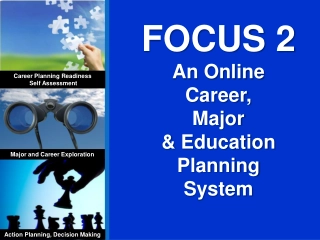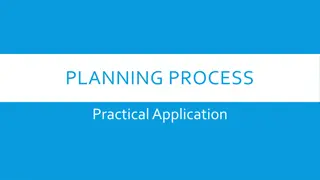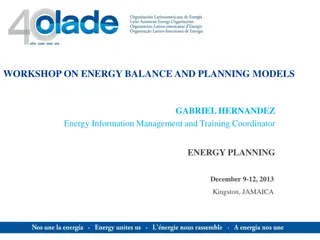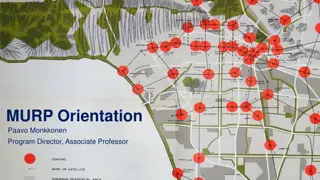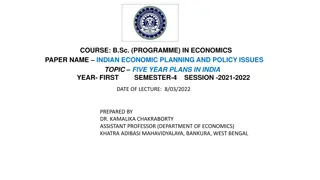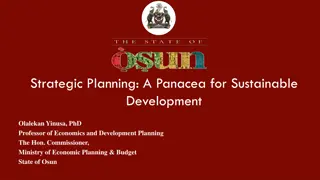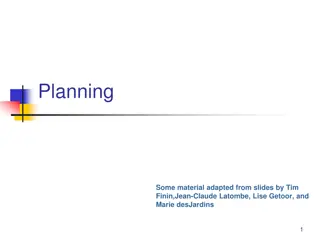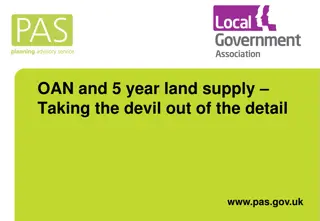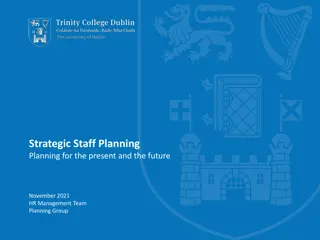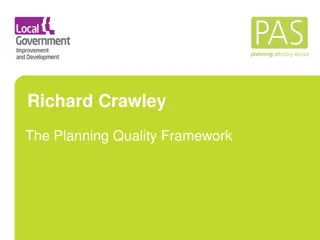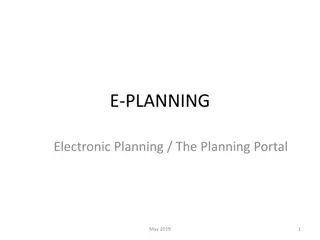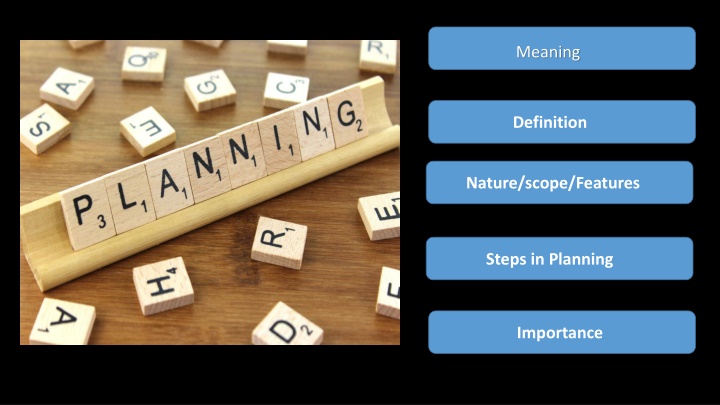
Essence of Planning in Management
Learn the meaning, definitions, nature, scope, features, steps, and importance of planning in management. Explore how planning is goal-oriented, forward-thinking, involving choice and decision-making, and serves as a fundamental function within an organization.
Download Presentation

Please find below an Image/Link to download the presentation.
The content on the website is provided AS IS for your information and personal use only. It may not be sold, licensed, or shared on other websites without obtaining consent from the author. If you encounter any issues during the download, it is possible that the publisher has removed the file from their server.
You are allowed to download the files provided on this website for personal or commercial use, subject to the condition that they are used lawfully. All files are the property of their respective owners.
The content on the website is provided AS IS for your information and personal use only. It may not be sold, licensed, or shared on other websites without obtaining consent from the author.
E N D
Presentation Transcript
Meaning Definition Nature/scope/Features Steps in Planning Importance
Meaning :- Planning is the function of management that involves setting Planning is the function of management that involves setting objectives and determining a course of action for achieving those objectives. objectives and determining a course of action for achieving those objectives. Planning requires that managers be aware of environmental conditions facing Planning requires that managers be aware of environmental conditions facing their organization and forecast future conditions. their organization and forecast future conditions. Defitions :- 1) George Terry :- Planning is the selecting and relating of facts and the making and using of assumptions regarding the future the visualisation & formulating of proposed activities believed necessary to achieve desired results. 2) Theo Haiman :- Planning is deciding in advance what is to be done, when a manager plans he projects a course of action for future, attempting to achieve a consistant coordinated structure of operations aimed at the desired results. 3) Hart :- Planning is the determination in advance of a line of action by which certain results are to be achieved.
Features/Nature/ Charactristics of Planning 1. Planning is Goal Oriented :- 1. a) Planning is made to achieve desired objective of business. b) The Goals established should general acceptance otherwise individual efforts & energies will gp misguided & misdirected. c) Planning identifies the action that would lead to desired goals quickly & economically. d) It provides sense of direction to various activities, E.g Maruti Udhyog is trying to capture once again Indian Car Market by launching diesel models. 2. Planning is looking ahead.:- a)Planning is done for future. b) It requires peeping in future, analyzing it & predicting it. c) Thus planning is based on forecasting. d) A plan is a synthesis of forecast. e) It is a mental predisposition for things to happen in future. 3. Planning is an intellectual process :- a) Planning is a mental exercise involving creative thinking, sound judgement & imagination. b) It is not mere guesswork but a rotational thinking. c) A manager can prepare sound plans only if he has a sound judgement, foresight & imagination. d) Planning is always based on goals, facts & considered estimates.
4. Planning involves choice & decision making :- a) planning essencially involves choice among various alternatives. b) Therefore if there is only one possible course of action, there is no need planning because there is no choice. c) Thus decision making is an integral part of planning. d) A manager is surrounded by no of alternatives. He has to pick the best depending upon requirements and resources of the 5. Planning is the primary function of planning:- a) Planning lays foundation for other functions of management. b) It serves as a guide for organizing, staffing, directing,& controlling. c) All the functions of Management are performed within the framework of plans laid out. d) Therefore planning is the basic or fundamental function of management. 6. Planning is a Continuous Process :- a) Planning is a never ending function due to the dynamic business environment. b) Plans are also prepared for specific period of time & at the end of that period,plans are subjected to revolution & review in the light of new requirements & changing conditions. 7. Planning is all Pervasive :- a) It is required at all levels of management & in all departments of enterprise. b) Of course, the scope of planning may differ from one level to another. c) The top level may be more concerned about planning the organization as a whole whereas the middle level may be more specific in departmental plans & the lower level plans implementation of the same. 8. Planning is designed for efficiency.:- a)Planning leads to accomplishment of objectives at the minimum possible cost. b) It avoids wastage of resources & ensures adequate & optimum utilization of resources.
c) A Plan is worthless or useless if it does not value the cost incurred on it 9. Planning is flexible :- a) Planning is done for the future. b) Since future is unpredictable, planning must provide enough room to cope with the changes in customer s demand,competition,Govt policies etc. c) Under changed circumstances, the original plan of action must be revised & updated to male it more practical.
Step 1 : Being Aware of opportunity :- Step 2 : - Establishing Objectives :- Step 3 :- Developing Premises :- Awareness of possible opportunities is very important for the planning process. It leads to the formulation of plans by providing clues whether opportunities exist for taking up a particular plan. Perception of opportunities includes a preliminary look at possible Opportunities & the ability to see them clearly & completely. During this stage,managers creat a foundation from which they will develop their plans to achieve goals. They examine the current state of where the organization stands in the light of its strength & weaknesses. The second step in the planning process is to establish objectives for the entire organization & then for each subordinate work unit. Organizational goals provide direction to & control the objectives of subordinate departments. Once organizational objectives are identified, the objectives of front line units & sub- units can be identified in that context. organizational objectives give direction to the nature of all major plans. After establishing goals & objectives , the next step is to develop planning premises, that is, the conditions under which planning activities will be undertaken. The forecasting process involves :- i) calculation of probable future events. ii) analyzing changes in consumer attitude, techonology, competitive forces, government policies etc. iii) developing the basis for decision making and planning by systematic way.
Step 4 :- Determining Alternatives Courses :- The next step is determining available alternatives ways of achieving objectives. Alternatives can be identified based on the planning premises & objectives of the firm. It is important to note that the number of alternatives should be reduced to the most promising & fruitful ones by preliminary analysis. Managers should search for & examine alternative courses of action.Alternatives can be discovered through research, experimentation & experience. Step 5 : - Evaluating Alternative Courses :- The planner in the light of premises & goals. Evaluation can be done by finding out the available alternatives & having made an analysis of their strong & weak points. Evaluation is not an easy process because alternatives have so many variables & limitations. Some alternatives can be compared easily, some may appear to be the most profitable & will be too expensive. Some may be less desirable or efficient than others. The best one is which better suits the organization s immediate goals. Step 6 :- Selecting the Best Alternative :- This is the point at which the plan is adopted the point of decision making. Selecting the most appropriate alternative involves choosing the plan. Normally, managers will select the alternative that, in their judgement, will best enable the organization to accomplish its goals. Step 7 :- Formulation of Supporting Plan :- After formulating the main plan/ basic plan, various sub-plans ( derivative plans) are derived so as to support the main plan. Derivative plans are specific plans which are departmental specific. In an organization , there can be various derivative plans like planning for buying equipment, collecting
Raw material,recruiting & training personnel, developing a new project etc. These derivative plans are formulated out of the main plan. Thereofre , they are meant to support the main plan. Step8 :- Establishing Sequence of Activities :- After formulating basic & alternative plans, the sequence of activities is determined so that plans are put into action efficiently & effectively. Based on plans at various levels, it can be decided who will do what & at what time so plans can be implemented in the right way.


